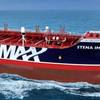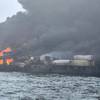MAIB: Multiple Errors in Hoegh Osaka Grounding
A number of reporting and operational errors caused the list and grounding of Höegh Osaka on January 3, 2015 according to an investigation by the Marine Accident Investigation Branch, UK.
The report into MAIB’s investigation of the listing, flooding and grounding of pure car and truck carrier Hoegh Osaka on the Bramble Bank, The Solent on 3 January 2015 is now published.
In his statement to the media, Steve Clinch, The Chief Inspector of Marine Accidents stated, "The MAIB’s investigation found that Hoegh Osaka’s stability did not meet the minimum international requirements for ships proceeding to sea. The cargo loading plan had not been adjusted for a change to the ship’s usual journey pattern and the number of vehicles due to be loaded according to the pre stowage plan was significantly different from than that of the final tally. The estimated weight of cargo was also less than the actual weight. Crucially, the assumed distribution of ballast on board, bore no resemblance to reality, which resulted in the ship leaving Southampton with a higher centre of gravity than normal.
"This accident is a stark reminder of what can happen when shortcuts are taken in the interest of expediency. It is therefore imperative that working practices adopted by the car carrier industry ensure that there is always sufficient time and that accurate data is available on completion of cargo operations to enable the stability of such vessels to be properly calculated before departure."
The Singapore registered pure car and truck carrier (PCTC) Hoegh Osaka was departing Southampton, UK, and turning to port around the Bramble Bank when the ship developed a significant starboard list. As the list increased in excess of 40º, the ship lost steerage and propulsion, and subsequently drifted aground on Bramble Bank. A cargo shift as the ship listed resulted in a breach of the hull and consequent flooding. All crew were safely evacuated from the ship and surrounding waters. There was no resulting pollution, and the ship was later successfully salvaged.
Stability modelling and analysis following the accident show that Hoegh Osaka listed heavily to starboard while turning around Bramble Bank as a result of having inadequate stability, which had not been identified prior to departure.
Safety Issues
- Assessing a ship has adequate stability for its intended voyage on completion of cargo operations and before it sails is a fundamental principle of seamanship that must not be neglected
- A loading computer is an effective and useful tool for the safe running of a ship. However, its output can only be as accurate as the information entered into it
- It is imperative that working practices enable correct information to be provided and that sufficient time is made available before departure for an accurate stability calculation to be completed
- An accurate stability calculation before departure is fundamental to safety











